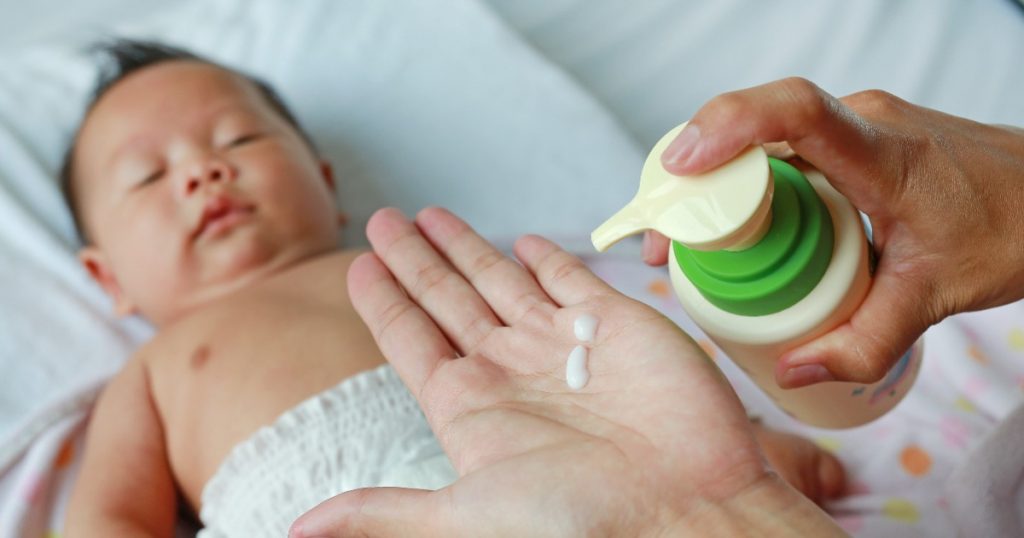Most infants are born with bruising, skin blotches, and blemishes, and this is a common occurrence, contrary to the popular belief of a lot of parents who think their newborn’s skin will be flawless.
Babies do have dry skin and chapping on their palms and feet for the first few weeks and there is nothing to be worried about. The blueness of palms and feet is also a likely occurrence and it usually goes off in a few weeks.
However, you need to keep a lookout for rashes in your baby. Most rashes and skin conditions are treated easily or cleared up on their own, but giving them enough care is always advisable. Here are some common skin problems in babies.
Baby acne:
- Small red and white bumps that are usually seen in the first few weeks of birth on the face, neck, upper chest, and back of some newborns are called baby acne.
- Washing their face and body gently with mild baby soap once a day will reduce baby acne.
- Avoid applying lotions, oils, and other baby acne treatments and never scrub, squeeze, or pinch the affected skin. The condition typically disappears without treatment within the first couple of months, without fear.
Erythema toxicum:
- A medical condition that is characterized by small white or yellowish bumps surrounded by reddish skin is called Erythema toxicum.
- It usually disappears within a few days of birth but in some cases, it gets flared up just before reducing by itself and you don’t have to stress about the flare-up. No treatment is necessary.
- The condition does not cause any discomfort or pain in babies.
Cradle cap:
- Cradle cap (infant seborrheic dermatitis) is redness and scaliness developing on the baby’s scalp due to oil-producing glands producing too much oil.
- It is common in the first few weeks of an infant’s life, clearing up by itself over a period of a few weeks or a couple of months.
- It may be mild, with flaky, dry skin that looks like dandruff, or more severe, with thick, oily, yellowish scaling or crusty patches.
- Shampooing with mild baby shampoo can help with cradle caps. Don’t be afraid to wash your baby’s hair frequently. Brushing your baby’s head with a soft brush will help remove scales.
- Visit your baby’s doctor if it spreads to other parts of your body.
Pustular melanosis :
- It is a condition that looks like small yellowish-white spots that look like sesame seeds that quickly dry and peel off.
- They may look similar to skin infections (pustules), but pustular melanosis isn’t an infection and disappears without treatment.
- The spots are commonly seen on the shoulders and upper chest and in the neck folds. It is more common in babies with darker skin.
Eczema /Rash Care:
- The dry, itchy, scaly red patches of skin often found around babies’ elbows or knees are due to eczema.
- It does not bother your baby if it affects smaller areas and treatment may not be needed, however, in some cases, eczema can cover a lot of skin and be extremely itchy and uncomfortable.
- In case the eczema is bad and has spread a lot, reach out to your baby’s doctor.
- Using fragrance-free baby soaps to wash your child and their bedding and clothing, dressing them in soft cotton clothing, bathing your baby daily with hypoallergenic bath oils, and keeping them away from dust, heat, and low humidity, can all help in preventing eczema in your baby.
Milia:
- Tiny white pimples or bumps on your baby’s nose, chin, and cheeks are due to Milia.
- If your baby has milia, you can wash his or her face once a day with warm water and a mild baby soap.
- Avoid using lotion, oils, or other products.
- Leave your baby’s skin alone and do not scrub it. Milia will disappear in time, most often in a couple of weeks
Read more: https://pranaamhospitals.com/blogs/here-are-some-tips-to-keep-your-baby-happy-in-summer_14816.html


